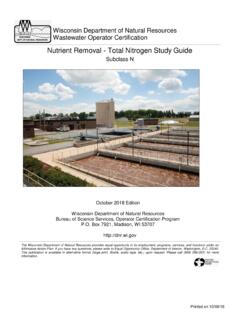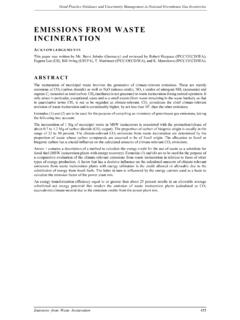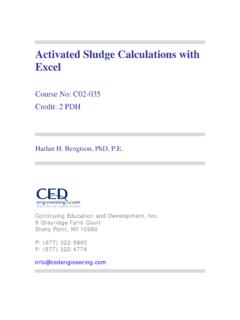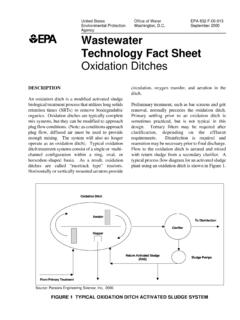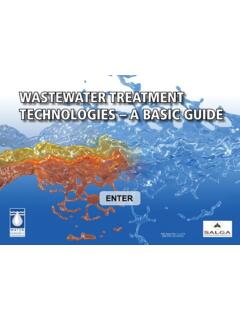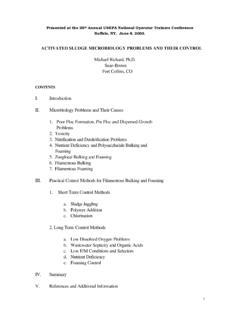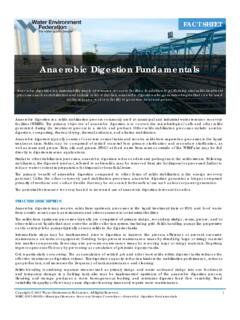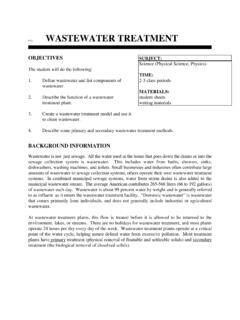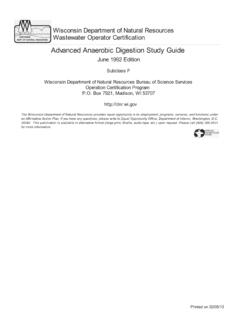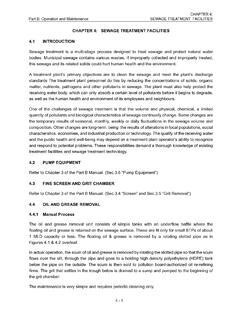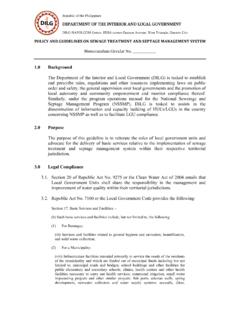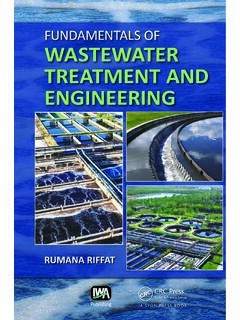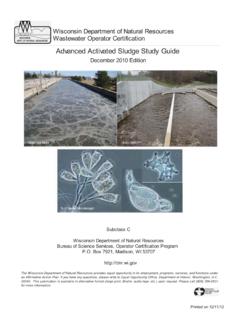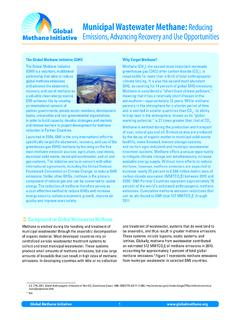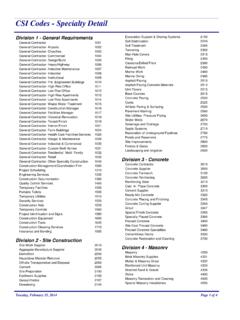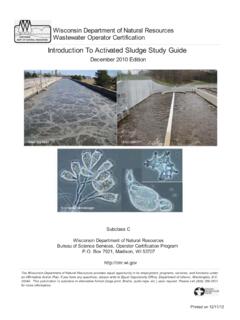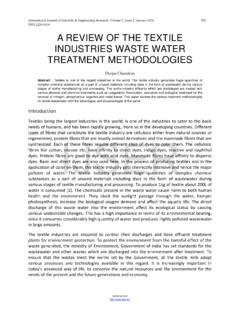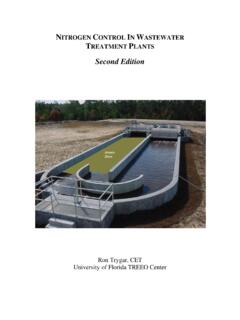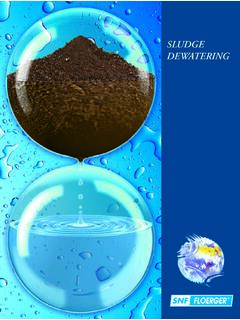Search results with tag "Sludge"
Sewage sludge management in Germany - Umweltbundesamt
www.umweltbundesamt.desludge 14 3 Sludge treatment 16 4 Thermal sludge treatment 23 Mono-incineration 23 Co-incineration 25 5 Sewage sludge use in the agricultural sector 29 Nutrients in sewage sludge 30 Sewage sludge pollutants 31 Pros and cons of using sewage sludge as a fertilizer 34 6 Phosphorous recovery 34 Phosphorous recovery potential and processes 36
Nutrient Removal - Total Nitrogen Study Guide
dnr.wi.govSludge age is the theoretical length of time a particle of activated sludge stays in the treatment plant and is measured in days. In an activated sludge plant, sludge age is the amount (lbs) of mixed liquor suspended solids (MLSS) divided by the suspended solids, or excess cell mass, withdrawn from the system per day (lbs/day of waste activated
6 SETTLING TESTS - Experimental Methods
experimentalmethods.orgconcentrations of the incoming sludge are typically in the range for hindered settling, and sludge thickening inside the sludge blanket is governed by compressive settling. In contrast to this, a specific characteristic of the granular sludge technology is the granules’ low tendency to coagulate under reduced hydrodynamic shear (de Kreuk
EMISSIONS FROM WASTE INCINERATION - IGES
www.ipcc-nggip.iges.or.jpThe sewage sludge delivered to the incineration plants in de-watered and/or partially dried condition usually has a water content of 50-70 percent. The calorific value of de-watered sludge averages 3,500 kJ/kg in the case of raw sludge (25 percent dry matter) and 2,500 kJ/kg in the case of digested sludge (25 percent dry matter). ...
ADVANCED WASTEWATER TREATMENT TECHNOLOGIES
gcpcenvis.nic.inADVANCED WASTEWATER TREATMENT TECHNOLOGIES ... ASP Activated sludge process SRT sludge retention time SOR sludge overflow rate WOR weir overflow rate MLD Million liter per day MLSS Mixed liquor suspended solid MLVSS Mixed …
SEQUENCING BATCH REACTOR DESIGN AND OPERATIONAL …
www.neiwpcc.orgSBRs are a variation of the activated-sludge process. They differ from activated-sludge plants because they combine all of the treatment steps and processes into a single basin, or tank, whereas conventional facilities rely on multiple basins. According to a 1999 U.S. EPA report, an SBR is no more than an activated-sludge plant that operates in ...
Sedimentation and Clarification Sedimentation is the next ...
www.oregon.govSludge Blanket Clarifiers Sludge blanket clarifiers are a variation of solids contact units in which coagulated water flows up through a blanket of previously formed solids. As the small, coagulated particles enter the sludge blanket, contact with other particles in the blanket causes flocculation to occur. The floc
CHAPTER 5: SLUDGE TREATMENT FACILITIES 5.1 …
cpheeo.gov.inSLUDGE TREATMENT FACILITIES A gravity thickener is shown in Figure 5.1 Figure 5.1 Example of a gravity thickener Continuous flow tanks are deep circular tanks with central feed and overflow at the periphery. Better efficiencies can be obtained by providing slow revolving stirrers, particularly with gassy sludge.
22. Painting / Coating Processes - NITE
www.nite.go.jppaint sludge is not available, water washing booth is deemed to have a concentration of 0.01 mass % (wi = 0.0001) and oil booth has 0.1 mass % (doi = 0.001) (refer to Reference-1) (3) The transfers contained in the paint sludge is estimated by [the amount of the paint sludge generated] × [solvent ingredient i concentration]. When the actual
Activated Sludge Calculations with Excel - CED Engineering
www.cedengineering.comconventional activated sludge system • Be able to describe the differences between a contact stabilization and conventional activated sludge system • Be able to calculate the required aeration tank volume (in U.S. units) for a specified volumetric loading, hydraulic residence time, or
Wastewater Technology Fact Sheet: Oxidation Ditches
www3.epa.govconventional treatment plants. The oxidation process originated in the Netherlands, Primary Sludge 0.5Q – 1Q Waste Activated Sludge Mixed Liquor Recirculation Secondary Clarifier Anoxic Aerobic Return Activated Sludge Primary Settling 3Q – 4Q Q Q Source: Parsons Engineering Science, Inc., 1999 FIGURE 2 THE MODIFIED LUDZACK-ETTINGER PROCESS
Review on Wastewater Treatment Technologies
www.ripublication.comThe granular sludge possessed an excellent settling property compared with the conventional floc sludge andtherefore enabling high biomass retention and dense microbial structures for withstanding high-strength organic wastewater and its shock loading[28]. According to Beun et al.[29], a mechanism for the formation of aerobic
WASTEWATER TREATMENT TECHNOLOGIES – A BASIC …
www.pseau.orgNitrogen and Phosphorus removal activated sludge processes no no yes yes no no no yes yes yes yes yes A Larger contributing community will require a more sophisticated plant Activated sludge process required for TN < 10 mg/ l High performance trickling filter with chemical phosphorus removal to achieve 10 <TN <20 P <1
CHAPTER 6: DESIGN AND CONSTRUCTION OF SLUDGE …
www.cpheeo.gov.intreatment processes are listed in Table 6.2. Table 6.2 Solids concentration by treatment process Source: Guideline and Manual for Planning and Design in Japan, JSWA, 2009 An illustrative solids balance in two different types of sludge treatment processes is shown in …
Activated Sludge Microbiology Problems and Their Control
www.dec.ny.govtroubleshooting the activated sludge process is based on microscopic examination and oxygen uptake rate (OUR) testing to determine the basic cause of the problem or upset and whether it is microbiological in nature. These methods are easy, fast and inexpensive compared to other approaches, and are generally understandable and accepted.
Wastewater Technology Fact Sheet: Package Plants
www3.epa.govtreatment system and is typically screened immediately to remove large suspended, settleable, ... This differs from the conventional flow through activated sludge process in that SBRs ... a modified form of the activated sludge process, is an aerated, long term, complete mix process. Many systems are designed
Environmental Protection Agency Wastewater Technology …
www3.epa.govsolids, to digest retained sludge, and to anaerobically reduce some of the soluble organic substrate. Raw wastewater enters near the bottom of the pond and mixes with the active microbial mass in the sludge blanket. Anaerobic conditions prevail except for a shallow surface layer in which excess undigested grease and scum are concentrated. Sometimes
Anaerobic Digestion Basics - uidaho.edu
www.extension.uidaho.eduAnaerobic digestion technology is being viewed as a way to address environmental concerns, generate renewable energy, cut bedding-material costs, reduce ... a given volume of sludge stays in the digester, is one of the most important design parameters affecting the economics of a digester. For a given volume of sludge,
Anaerobic Digestion Fundamentals
www.wef.orgAnaerobic digesters may receive solids from upstream processes in the liquid treatment train or FOG and food waste from outside sources such as restaurants and other commercial or industrial facilities. The solids from upstream processes typically are comprised of primary sludge, secondary sludge, scum, grease, and/or
SEDIMENTATION - MRWA
www.mrwa.comunits are also called upflow clarifiers or sludge-blanket clarifiers. These units are used primarily with lime-soda ash to settle floc formed during water softening. Flow is usually in an upward direction through a sludge blanket or slurry of flocculated suspended solids.
WASTEWATER TREATMENT - The Water Project
thewaterproject.orgof wastewater facilities also employ tertiary treatment, often using advanced treatment methods. ... Settled solids (sludge) from primary treatment and secondary treatment settling tanks are given further treatment and undergo several options for disposal. (See Sludge Treatment and Disposal Methods on page 2-87 & 2-114 thru 2-115.) Terms
Advanced Anaerobic Digestion Study Guide
dnr.wi.govanaerobic digestion in Wisconsin is operated in the mesophilic range normally operating between 90 degrees - 98 degrees F. The expected reduction of volatile solids of a properly operating digester is 40-60% of the total volatile solids present in raw sludge feed. The volatile solids in the feed sludge would
CHAPTER 4: SEWAGE TREATMENT FACILITIES 4.1 …
www.cpheeo.gov.in4.6.4 Troubleshooting Troubleshooting is as given in Appendix B.4.1. 4.7 ACTIVATED SLUDGE PROCESS (ASP) The activated sludge process is still the most widely used biological treatment process for reducing the concentration of organic pollutants in sewage. Well-established design standards
POLICY AND GUIDELINES ON SEWAGE TREATMENT AND …
www.dilg.gov.phis required or accepted by existing environmental laws and policies; aa.Sewerage System – this involves the collection of sewage from households which will be conveyed through the sewer pipelines going to a Sewage Treatment Plant or STP. bb.Sludge – a solid particle of domestic sewage which settles at the bottom of the
Fundamentals of Wastewater Treatment and Engineering
priodeep.weebly.comDisposal of wastes and wastewater without treatment is no longer an ... and advanced treatment as well as solids processing and removal. Using detailed calculations, it discusses energy production from wastewater. ... 8.3 Activated sludge process (for BOD removal) 126
Advanced Activated Sludge Study Guide
dnr.wi.govHow to use this study guide with references In preparation for the exams you should: 1. Read all of the key knowledge’s for each objective. 2. Use the resources listed at the end of the study guide for additional information. 3. Review all key knowledge’s until you fully understand them and know them by memory.
Land Application of Sewage Sludge, EPA/831-B-93-002b ...
www3.epa.govAll other requirements (i.e., reporting, general requirements, pollutant limits, pathogen reduction, vector attraction reduction, and management practices) July 20, 1993 February 19, 1994* *If compliance requires construction of new pollution control facilities, compliance is required as expeditiously as possible but no later than February 19 ...
Municipal Wastewater Methane: Reducing Emissions ...
www.globalmethane.orgInstalling anaerobic sludge diges-tion (new construction or retrofit of existing aerobic treatment systems) Anaerobic digesters are used to process wastewater biosolids and produce biogas, which can be used on site to offset the use of conventional fuel that would otherwise be used to produce electricity and thermal energy.
Biological Nutrient Removal Processes
www.acsawater.com1968 Barth Proposes Multiple Sludge Processes For Nutrient Removal. 1969 Scalf, Et. Al., Report On Excess Biological Phosphorus Removal At Baltimore, Maryland Back River Wastewater Treatment Plant. Biological Nutrient Removal Processes. Milestones 1970 Savage Patents Denitrification Filter.
Chapter 16 - Anaerobic Wastewater Treatment
ocw.tudelft.nlsludge production in anaerobic reactors is an immediate economic benefit. The system compactness, another important asset of AnWT, can be illustrated by a full-scale example, where an anaerobic reactor with a 6 m diameter and a height …
COMPOSITION AND QUANTITY OF SOLID WASTE
cpheeo.gov.inconditioner but invariably its use for this purpose is uneconomical. The solid sludge therefore enters the stream of municipal wastes unless special arrangements are made for its disposal. 3.2.2 Classification ... boiler house cinders, wood, plastic and metal scraps and sha
CSI Codes - Specialty Detail - CT ABC
www.ctabc.orgDewatering 2140 Excavation Support & Shoring Systems 2150 Soil Stabilization 2240 Soil Treatment 2280 Tunneling 2300 Man Hole Covers 2315 Piling 2350 ... Sludge Conditioning Systems 13260 Utility Control Systems 13300 Industrial and Process Control Systems 13400 Recording Instrumentation 13500
PROBLEM OPERATOR SOLVERS ESSENTIALS
www.wef.orgper shift for multishift operations. A sludge blanket depth of target of .3 to .6 m (1 to 2 ft) is adequate for most treatment facilities. For best performance, a good rule-of-thumb is to maintain the blanket of 0.6 m (2 ft) or less at all times. A common operational target for RAS flow rates is to maintain flows between 50% and 150%
Introduction To Activated Sludge Study Guide
dnr.wi.govA condition in which free and dissolved oxygen is available in an aqueous environment. A condition in which oxygen is only available in a combined form such as nitrate (NO3-), nitrite (NO2-), or sulfate (SO4) in an aqueous environment. A condition in which free, dissolved, and combined oxygen is unavailable in an aqueous environment. 1.1.9 1.1 ...
The Determination of Chemical Oxygen Demand in ... - GOV.UK
assets.publishing.service.gov.ukwater, waste water and effluents as well as sewage sludges, sediments, soil (including contaminated land) and biota. In addition, short reviews of the most important analytical techniques of interest to the water and sewage industries are included.
Anaerobic Digestion 101 - WEF Home
www.wef.orgNov 02, 2017 · Sludge Screening Pre-Dewatering Cake Storage THP HEX Anaerobic Digestion Blending Thickened WAS THP Background - History • First full scale THP system commissioned in 1995 by Cambi • HIAS plant Lillehammer, Norway • Original vessels are still in operation • Kruger/Veolia 1st pilot plant 2004 (Biothelys) full scale ~2009.
Executive Report: How to Write a Winning NSF Proposal
www.unomaha.eduexecutive director of the Maricopa Advanced Technology Education Center (MATEC), an NSF-funded center of excellence, since its inception in 1996. Dr. ... Broader Impact, from the NSF-awarded project “Effect of Activated Sludge Bioselector Designs on …
A Review of the Textile Industries Waste Water Treatment ...
www.ijser.orgsystem again [1]. SECONDARY TREATMENT PROCESS . Organic matter is a source of energy and nutrients for aerobic bacteria. They oxidize organic matter to from CO2 and water degrade nitrogenous organic matter into ammonia. Aerated lagoons, trickling filter and activated sludge systems are among the aerobic system used in the secondary treatment.
CHAPTER 3 PRIMARY TREATMENT - wefnet.org
www.wefnet.org10 • Identify the basic principle underlying the primary treatment process; 11 • Describe the components of primary se dimentation tanks including inlet and 12 outlet structures; 13 • Explain the main considerations for sludge and scum removal and disposal; 14 • List the factors that affect primary sedimentation tank efficiency;
FINAL Nitrogen control in wastewater treatment plants v4
treeo.ufl.edutreatment facilities, activated sludge process control and troubleshooting, biological nutrient removal, microscopy, and a variety of exam review courses that help operators prepare for the state exams. Ron teaches sections of the Water Facility Security and Water Distribution System courses, and also is the instructor of the UF Dept. of
VVITMEE-2022 VITMEE Syllabus
vit.ac.inter standards, water requirements, basic unit opera ons and unit processes for surface water treatment, dis-tribu on of water. Sewage and sewerage treatment, quan ty and characteris cs of waste water. Pri-mary, secondary and ter ary treatment of waste water, sludge disposal, effluent discharge standards. Do-
4500-NH NITROGEN (AMMONIA)* 4500-NH A. Introduction
www.edgeanalytical.comb. Sludge or sediment samples: Rapidly weigh to within 1% an amount of wet sample, equivalent to approximately1gdry weight, in a weighing bottle or crucible. Wash sample into a 500-mL kjeldahlflask with water and dilute to 250 mL. Proceed as in ¶ 4a but add a piece of paraffin wax to distillation flask and collect only 100 mL distillate.
TABLE OF CONTENTS FOOD AND AGRICULTURAL CODE
www.cdfa.ca.govinclude gypsum, liming materials, manure, wood fly ash, sewage sludge not qualifying as commercial fertilizer, and captured dilute solutions. 14512.5. “Ammonium nitrate” means solid ammonium nitrate that is chiefly the ammonium salt of nitric acid, contains not less than 33 percent of nitrogen, one-half of
ABS submersible sewage pump AFP 0831-2046
www.pumpfundamentals.comsewage and sludge, in fixed or portable applications. * For fixed, wet well applications the AFP is pedestal mounted. Us-ing a self-sealing coupling system the pump seals automatically on the pedestal when lowered by guide rail into position. * Dry well applications have the option of horizontal or vertical installation.
How Wastewater Treatment WorksThe Basics
www3.epa.govsludge process. After effluent leaves the sedimentation tank in the primary stage it flows or is pumped to a facility using one or the other of these processes. A trickling filter is simply a bed of stones from three to six feet deep through which sewage passes.
SLUDGE DEWATERING - SNF Holding Company
us.snf.comThe characteristics of this sludge is the direct result of the chemicals used (mineral or organic coagulants) and of course of the pollutants in the water. 1.2.6. Mineral sludge: This name is given to sludge produced during mineral processessuch as quarries or mining beneficiation processes.
Sludge Treatment and Disposal - SSWM
sswm.info7.5 Criterion for selecting sludge treatment and final disposal alternatives 155 7.6 Sludge management at the treatment plant 160 8 Land application of sewage sludge 162 C.V. Andreoli, E.S. Pegorini, F. Fernandes, H.F. dos Santos 8.1 Introduction 162 8.2 Beneficial use 163 8.3 Requirements and associated risks 169 8.4 Handling and management 177
Sludge Volume - Weight Relationships - University of Guelph
www.soe.uoguelph.casludge _volume. wpd Page 1 of 2 Sludge Volume - Weight Relationships The volume of sludge depends on two items: # water content # solids content Furthermore, the solid content is a function of fixed and volatile soils. Therefore, the specific gravity of all the solid matter is described by: where M s = mass of solids, kg S s = overall specific ...
Similar queries
Sludge, Processes, Activated sludge, Activated, Sludge blanket, EMISSIONS FROM WASTE INCINERATION, Sewage sludge, Advanced, Sedimentation and Clarification Sedimentation is, Blanket, SLUDGE TREATMENT FACILITIES, Conventional activated sludge, Oxidation, Conventional, WASTEWATER TREATMENT TECHNOLOGIES – A BASIC, Troubleshooting, Package, System, Modified, Anaerobic, Anaerobic Digestion Fundamentals, Sludge-blanket, Treatment, Facilities, Sludge Treatment, Digester, Troubleshooting Troubleshooting, Sewage, Environmental, Wastewater Treatment, Disposal, Wastewater, Activated Sludge Study, Study, General, Construction, Anaerobic sludge, Sludge Processes, COMPOSITION, SOLID WASTE, Conditioner, Boiler, Dewatering, Treatment facilities, Aqueous, Sewage sludges, Land, Anaerobic Digestion 101, Textile Industries Waste Water Treatment, And disposal, Water, Waste water, Sediment, ABS submersible sewage pump AFP 0831, SLUDGE DEWATERING, Risks, Sludge Volume - Weight Relationships

